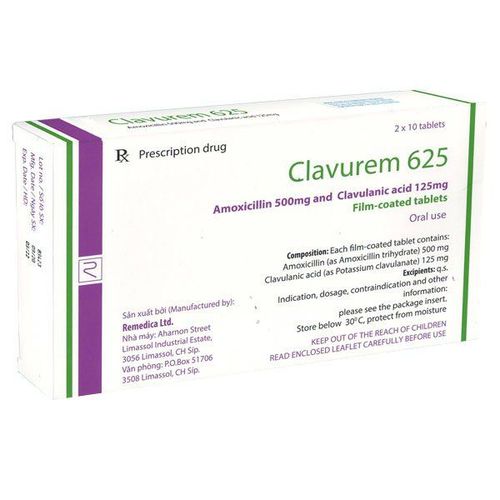This is an automatically translated article.
Cefnirvid 300 is a special antibiotic, anti-viral, anti-fungal parasite treatment. So to find out specifically what Cefnirvid 300 does? how does it use? What are the side effects of Cefnirvid 300? Let's learn the necessary information about the use of Cefnirvid 300 through the article below.
1. What does Cefnirvid 300 do?
1.1. What is Cefnirvid 300? Cefnirvid 300 is a drug used in the treatment of parasites, anti-infectives, antivirals, antifungals. Cefnirvid 300 is made in the form of easy-to-take tablets, Cefnirvid 300 is used to treat mild infections such as bronchitis, pharyngitis, tonsillitis... With drug visa number: Registration number / registration number: VD - 23688 - 15 is manufactured by the branch of Vidipha Central Pharmaceutical Joint Stock Company in Binh Duong in VIETNAM. Cefnirvid 300 contains Cefdinir 300mg and is packaged as a film-coated tablet, a box of 2 blisters of 5 tablets and a box of 2 blisters of 10 tablets each.
Cefnirvid 300 is a product indicated for the treatment of mild to moderate infections caused by susceptible bacteria caused by: acute pneumonia, chronic bronchitis, sinusitis, acute otitis media , pharyngitis, tonsillitis, uncomplicated skin infections and skin structure infections.
1.2. Uses of Cefnirvid 300 Cefnirvid 300 is an antibiotic with a cephem nucleus, having a vinyl group at the 3rd position and a 2-aminothiazole hydroxyimino group at the 7th position of 7-aminocephalosporanic acid. Cefnirvid will not be affected by beta-lactamase enzymes, it has broad antibacterial activity against gram(-) and gram(+); especially, it is very effective against gram (+) bacteria such as: Staphylococcus sp., Streptococcus sp., resistant to other pre-existing oral cephalosporin antibiotics. Cefnirvid is a bactericidal drug, it has a balanced bactericidal activity, against gram(-) bacteria and gram bacteria: The mechanism of action of Cefnirvid is inhibition of cell wall synthesis. It has a very high affinity for penicillin-binding proteins (PBP),1 (1a, 1bs), 2, 3 and with variable points of action depending on the type of bacteria.
Uses of Cefnirvid 300
Cefnirvid 300 is used to treat infections caused by susceptible strains of bacteria such as: ear - nose - throat infections, bronchitis, pneumonia, urinary tract infections, genital, uncomplicated gonorrhea, treatment of infections in obstetrics and gynecology, infections of skin and soft tissue, prevention of post-operative infections.
Patients should adhere to the correct use of the drug as indicated, such as the uses and functions for the subjects listed in the Cefnirvid 300 instruction sheet.
2. How to use Cefnirvid 300
2.1. How to take Cefnirvid 300 Each drug, pharmaceutical product is manufactured in different forms and has different ways of administration and routes of administration. The routes of drug administration will be classified according to the form of drugs: drugs for oral use, or drugs for injection, drugs for external use or suppositories. Please carefully read the instructions on how to use Cefnirvid 300 on the drug instruction sheet, do not arbitrarily use the drug by other routes not stated in the instruction sheet. Cefnirvid 300 tablets should be taken orally, not with meals.
2.2. Dosage of Cefnirvid 300 Dosage:
Children over 12 years old and adults: Take 2 times a day, 1 tablet each time, 12 hours apart, the indicated duration of treatment is from 5 to 10 days, or according to your doctor's detailed instructions.
Children from 6 months old to 12 years old: The usual dose is 14mg/kg per day (maximum use 600mg per day).
Patients with renal failure : Clearance is not more than 30ml/min, dose is 300mg/time per day..
2.3. Handling overdose, missed dose when taking Cefnirvid 300 Missed dose: Usually, the drug can be taken within 1-2 hours compared to prescribed in the prescription. Unless your doctor prescribes a strict time limit for taking your medication, it can be taken a few hours after forgetting. But, if the time is too far from the time to drink, the patient should not take the supplement, which can be dangerous to the body. It is necessary to strictly adhere to or consult a doctor before making a decision.
Handling missed dose: If the patient forgets to take a dose, take it as soon as possible. But if it is almost time for the next dose, skip the missed dose and take the next dose. Never take a double dose as prescribed.
Overdose: Prescription drugs require a prescription from a doctor or pharmacist. Over-the-counter medicines require a leaflet from the manufacturer. Carefully read and follow the exact dose indicated on the prescription or medication leaflet.
Unusual symptoms of overdose should be reported to the doctor or medical person in charge. In case of drug overdose with emergency symptoms: Call 911 immediately for guidance and help. Family members should bring medical records, all prescriptions/pots of medicine that have been and are being used so that doctors can quickly diagnose and treat
Overdose treatment: Symptoms: Information about overdose Dosage for cefdinir has not been established in humans. Symptoms and signs of toxicity due to overdose of beta-lactam antibiotics have been reported) such as nausea, vomiting, epigastric pain, diarrhea and convulsions. Treatment: There is no specific antidote, in case of overdose, gastric lavage should be carried out to remove the unabsorbed drug from the body. Hemodialysis may decrease cefdinir concentrations, especially in the presence of impaired renal function.
3. Contraindications of Cefnirvid 300
Cases where the patient should not take Cefnirvid 300
Hypersensitivity to Cephalosporin antibiotics.
People who are sensitive or allergic to any of the ingredients in Cefnirvid 300 should absolutely not use the drug. Other cases are specified in the drug leaflet or doctor's prescription. Contraindications of the drug Cefnirvid 300 must be understood as an absolute contraindication, which means that for any reason, the cases of contraindicated patients are not flexible enough to be used.
What drugs can interact with Cefnirvid 300? It is important to remember that drug interactions with other drugs are often quite complicated due to the influence of many ingredients in the drug. Studies or recommendations usually only state common interactions with use. Therefore, do not arbitrarily apply Cefnirvid 300 drug interaction information if you are not a researcher, doctor or medical person.
Drug interaction Cefnirvid 300 with food, drink Consider when using together with alcohol, tobacco, alcoholic beverages or fermentation. Factors that can change the composition of the drug. See details in the leaflet or consult your doctor or pharmacist for more details.
4. Notes when using Cefnirvid 300
Notes and cautions before taking Cefnirvid 300: People with a history of hypersensitivity to penicillin, patients with renal failure, patients with a history of colitis. - Pregnant and lactating women. People who need to be careful before taking Cefnirvid 300: the elderly, pregnant women, lactating women, children under 15 years old, people with liver failure, kidney failure, people with hypersensitivity to any substance Which of the ingredients in the drug... Or subjects with myasthenia gravis, hepatic coma, stomach ulcers
Note during pregnancy: Can pregnant women take Cefnirvid 300?
Consider and consult your doctor or pharmacist before taking medicine. Even tested drugs still have risks when used.
Note the breastfeeding period: Mothers need to carefully weigh the benefits and risks for mother and baby. Do not arbitrarily use the drug without carefully reading the instructions for use and instructions of the doctor to protect the mother and baby
Use for drivers and operate machines
The drug does not affect the ability to drive and operate machinery.
5. Side effects of Cefnirvid 300
Steven - Johnson syndrome, toxic epidermal necrolysis, exfoliative dermatitis, erythema multiforme, erythema nodosum. Serum disease. Conjunctivitis, stomatitis. Acute/paroxysmal hepatitis, cholestasis, liver failure, jaundice. Amylase elevation, anaphylaxis, facial and laryngeal edema, feeling of suffocation. Enteritis, acute colitis, bloody diarrhea, hemorrhagic colitis, melena, pseudomembranous colitis. Hematologic changes, renal failure. Acute respiratory failure, asthma attack, drug-induced pneumonia, eosinophilic pneumonia, idiopathic interstitial pneumonia. Fever, kidney disease. Hemorrhagic tendency, upper gastrointestinal bleeding, peptic ulcer, intestinal obstruction, loss of consciousness. Allergic vasculitis, heart failure, chest pain, myocardial infarction, hypertension, voluntary exercise, rhabdomyolysis. Coomb's test, urine ketone/glucose: (+) false.. Rare: nausea, abdominal pain, pseudomembranous enteritis. - Hypersensitivity reactions: allergic reactions in the form of rash, pruritus urticaria These reactions usually subside upon discontinuation of the drug. Inform your doctor of any unwanted effects encountered while using the drug. Usually, side effects or undesirable effects (ADRs) are unwanted effects that go away when the drug is stopped. If there are rare side effects that are not mentioned in the leaflet. Immediately notify your doctor or medical officer if you suspect any side effects of Cefnirvid 300
6. How to store Cefnirvid 300
Keep the medicine at a temperature below 25°C, protected from light.
Keep medicine out of reach of children.
Carefully read the instructions for storing the drug on the package and the instruction sheet for Cefnirvid 300. Check the expiry date of the medicine. When not in use, the drug should be collected and disposed of according to the manufacturer's instructions or the person in charge of medicine. Conventional drugs are stored at room temperature, avoiding direct sunlight or high temperature, which can metabolize the ingredients in the drug. Cefnirvid 300 has a shelf life of 36 months from the date of manufacture.
Please dial HOTLINE for more information or register for an appointment HERE. Download MyVinmec app to make appointments faster and to manage your bookings easily.













